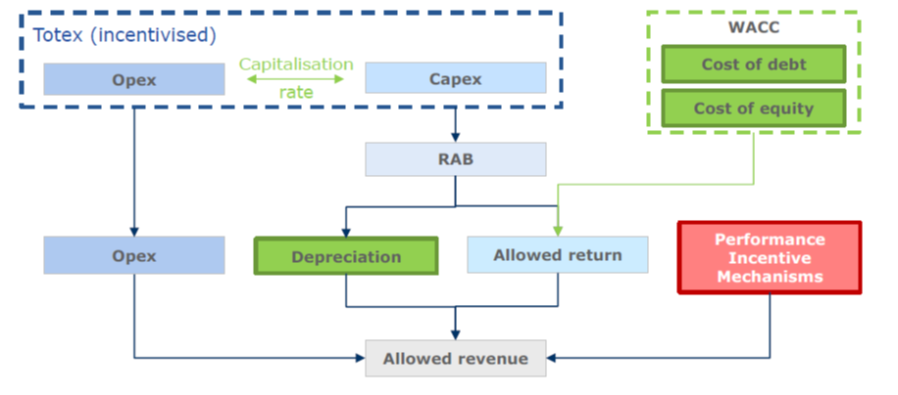Abolishing acronyms: a TOTEX approach
Internationally, regulators are exploring and rethinking approaches to capital investment for better customer outcomes. In Australia, the Australian Energy Market Commission and others are doing the same. What does it all mean?
CAPEX and OPEX, or TOTEX?
The delivery of network services is advancing with a rapidity not witnessed in decades. Australian networks are at the cutting edge – trialling energy storage, blockchain approaches, and demand management initiatives. Yet, despite the ‘technological development’ many parts of network regulation have not kept pace.
There is a sound case for stability in approaches to provide the efficient capital that underpins investment in essential energy infrastructure for customers. Yet there is benefit in keeping our eyes on the horizon for new approaches that may help deliver better outcomes for customers.
One utility sector regulatory innovation trialled in the United Kingdom and other European countries is the use of a ‘total expenditure framework’ or TOTEX. This framework is a change to how expenditure allowances are set, measured and reported.
TOTEX in a nutshell
Under current “building block” approaches the regulator separately assesses and reaches targets for operating costs (such as maintaining poles and pipes), and longer term capital investment costs (such as expanding, replacing or upgrading network assets).
At its core, the TOTEX approach to setting revenue remains a “building blocks” approach. However, under a TOTEX approach, regulated networks would be given a single expenditure allowance, with a pre-determined capitalisation rate[1]. That is, the distinction between capital and operating expenditure is removed (See Figure 1).
Figure 1 TOTEX and the building blocks approach

Source: CEPA, Future Regulatory Options for Electricity Networks, Report for Energy Networks Association and CSIRO, p.52.
Why TOTEX?
The Energy Networks Australia-CSIRO Electricity Networks Transformation Roadmap (the Roadmap) identifies that “a regulatory regime that is outpaced by technology and market developments cannot protect consumers or deliver a balanced scorecard of societal outcomes.”[2]
A TOTEX approach may have significant customer benefits. For example, it could:
- Improve stakeholder and customer confidence that perceived ‘bias towards building’ is removed. A frequent criticism of current frameworks is that they may lead to underinvestment in innovative operational solutions and subsequent potential losses in customer value.[3] The TOTEX approach represents a powerful potential solution.
- Focus decisions on the best value solution for customers over the life of the asset. Where long-lived assets are being funded, the customer gains from better optimisation and optionality can be significant.
- Better reflect what the current system says it does now. This is achieved by approving overall efficient allowances, rather than approving specific capital and operating projects.
- Improved simplicity. TOTEX would reduce the bureaucratic and complex regulatory requirements, and streamline incentive scheme approaches that have dominated network regulation over the past decade.
- Reduce the regulatory disputes and monitoring costs around capital and operating cost allocation, and the capital and operating mixtures in benchmarking.
The goal is to ensure that the regulatory framework best allows networks to respond to the risks and opportunities created by transformational changes to benefit consumers.
International experience
Ofgem is in the early review phase of its ‘RIIO’ (or Revenue=Incentives+Innovation+ Outputs) framework introduced in 2010. A key part of RIIO is reliance on the TOTEX approach and efficiency incentive to encourage networks to consider alternative, innovative operating expenditure solutions where this is more efficient.
Figure 2 Initial stakeholder feedback on the TOTEX approach

Source: Ofgem presentation, RIIO-2 Stakeholder workshop, Delivering what consumers need, 23 October 2017
Ofgem has reflected that:
Changes to how the gas distribution networks deliver the gas mains replacement programme in their 2013-21 price control also show how totex encourages innovation. The programme is no longer seen purely as capital expenditure asset replacement. Using new technology, networks are making mains inspections online, carrying out remote repairs and employing advanced leakage management. The aim is to repair some mains where possible instead of replacing them. The benefit to customers is a reduction in costs of around £2 billion over the price control, without any compromises on safety.[4] Maxine Frerk, Senior Partner, Smarter Grids and Governance Distribution, Ofgem
Another leader in regulatory innovation is Italy. In 2015, the Italian Regulatory Authority for Electricity Gas and Water adopted the TOTEX approach, combined with incentive menus and output-based incentive schemes. Similar to Ofgem, the goal was to focus network business towards the valued investments in terms of outputs (e.g. quality) and services for consumers.[5]
These case studies led Cambridge Economic Policy Associates (in expert advice to the Roadmap) to suggest that in the medium-term the evidence supports a move away from existing schemes to TOTEX based approaches. The Roadmap recommended that TOTEX be trialled by 2018 and, if successful, implemented by 2027.
Australian policymakers are looking in the same direction. Over 2018, the Australian Energy Market Commission will undertake a review of the overarching design of the incentive regime, including the topic of a possible TOTEX framework.[6]
The AEMC’s intention to investigate a TOTEX framework is a welcome step. Given the potentially significant transformation of the energy sector, a clear conversation on the purpose and expectation of a regulatory framework is required.
TOTEX may be an important innovation, but is only part of the solution
Improve engagement on network revenue proposals
The optimum future framework is also likely to include wider process changes beyond TOTEX or other models. For example, Energy Networks Australia, together with the Australian Energy Regulator and Energy Consumers Australia, are investigating regulatory determination models which better enable the views of consumers to inform and shape network businesses proposals. The project also considers how the regulator can place increased weight on agreed outcomes.
Designing tools to encourage innovation
The adoption of the TOTEX approach will encourage more innovation by networks. However, this is not the only policy response required to incentivise network innovation. Electricity and gas networks need to have an environment in which the risks of innovation, including the failures of attempts to innovate, can be managed. Energy Networks Australia undertook preliminary research on the value of innovation amongst network service providers. Recommendations included a network innovation scheme addressing a range of concerns about the lack of sufficient network innovation funding and programs.[7]
What is next?
The design of alternative regulatory approaches is more than just replicating the international experience. The network sector is keen to explore new approaches that have the potential to ensure customers can access energy services they value. Upcoming reviews are an important opportunity to make the regulatory framework more responsive. TOTEX has the potential to replace two well-worn acronyms Capex and Opex, with one!
[1] The proportion of total expenditure that is added to the regulatory asset base.
[2] CSIRO and the Energy Networks Association, Electricity Network Transformation Roadmap, Interim Program Report, p.16.
[3] ISF, Demand Management Incentives Review: Creating a level playing field for network Demand Management in the National Electricity Market, June 2017, p.iii.
[5] https://www.oxera.com/Latest-Thinking/Agenda/2016/Electricity-network-regulation-in-Italy-moves-towa.aspx
[6] AEMC, Draft Rule Determination, Contestability of energy services. p55-56.
[7] Energy Networks Australia, Network Innovation Discussion Paper, July 2017

